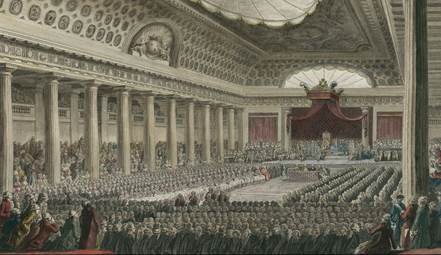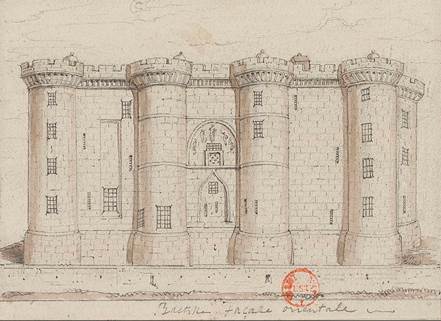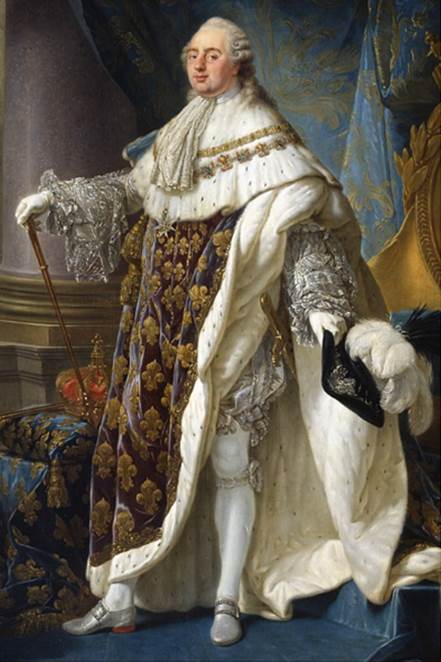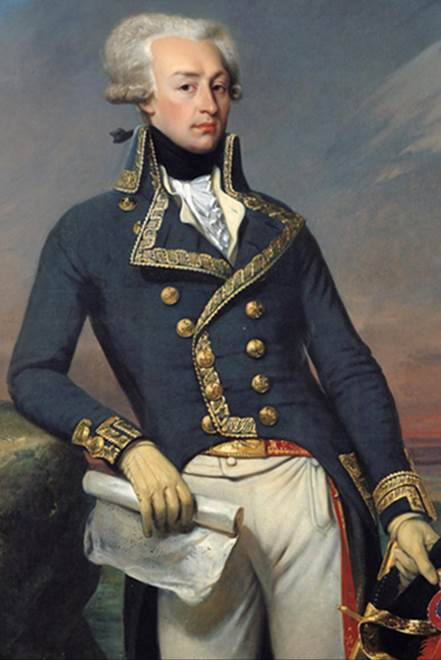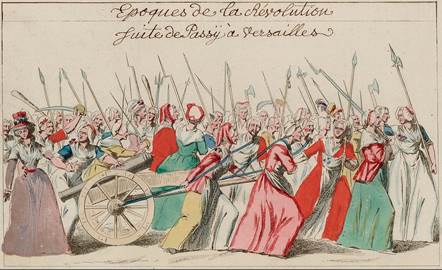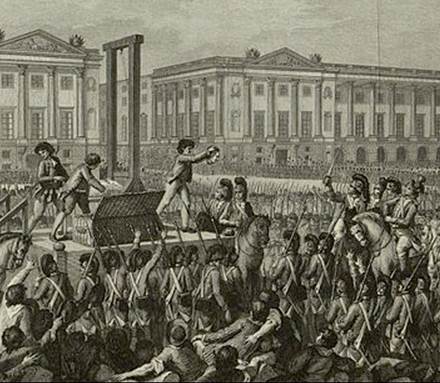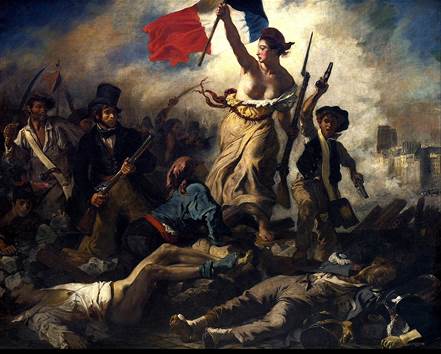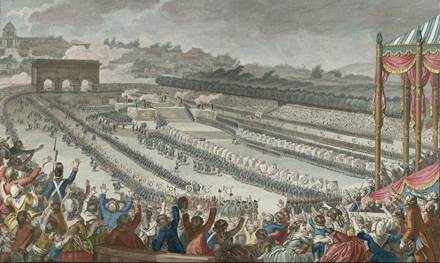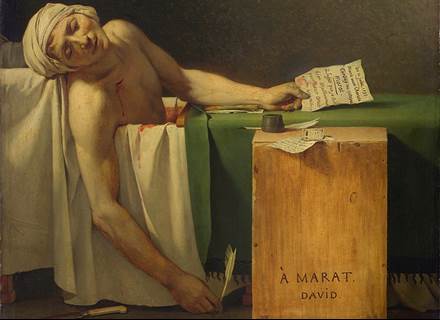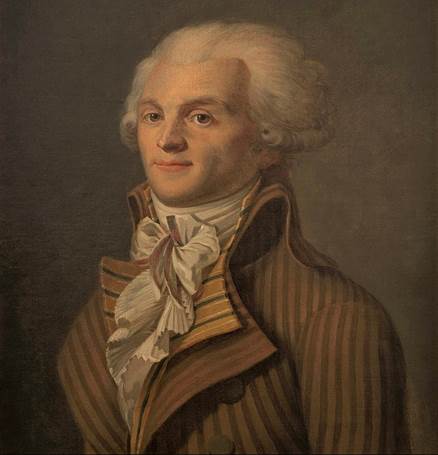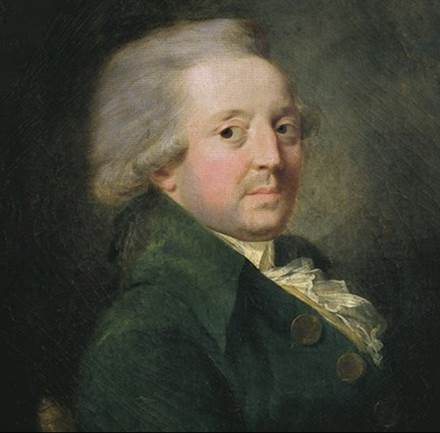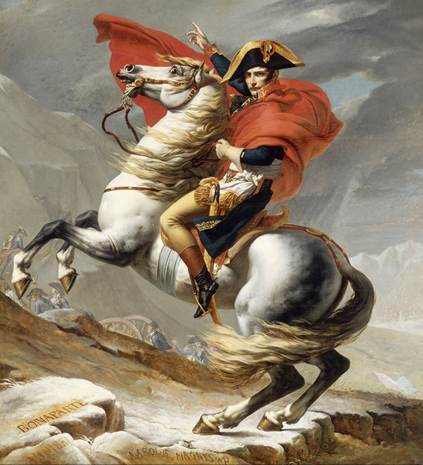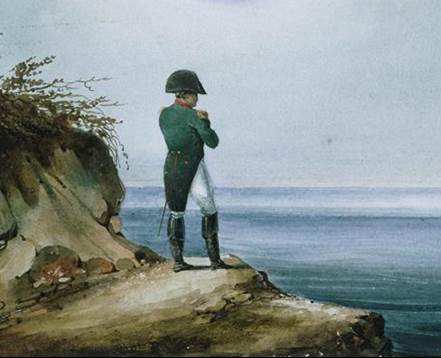News of the revolution in America also triggered a revolution in France, but where America had been able to create a government from scratch, France was weighed down by centuries of aristocratic rule—and the nobles were not eager to give up their power. In opposition to these forces, many revolutionaries radicalized. They executed their king by guillotine and eventually even persecuted the moderate members of their own movement, leading to a period known as the Reign of Terror. With the king removed, France became a republic, until it was taken over by Napoleon, who crowned himself emperor of France.
The Ancien Regime
At the time, France was ruled by King Louis XVI (1754–1793), who was part of a monarchic tradition known as the Ancien Regime (“ancient regime”). Believing he ruled by the divine right of kings, Louis did not recognize the rule of law, which allowed the aristocracy to get away with almost anything. The king also lived in total luxury—exemplified by his Palace of Versailles and the frivolous lifestyle of his wife Marie Antoinette (1755–1793)—while many of his subjects suffered from hunger.
Following medieval tradition, French society was separated into three groups, or estates, each with different functions and legal statuses. The First Estate consisted of “those who pray,” the clergy; the Second Estate of “those who fight,” the nobility; and the Third Estate consisted of “those who work,” ranging from peasants to wealthy non-noble merchants. The first two estates made up only one percent of the population and enjoyed various privileges. For instance, they were free from almost all taxes. Over the centuries, people had rarely questioned this system, since it was believed to be sanctioned by God. Even those at the bottom had accepted it as a given.
The National Assembly
A series of events during the 18th century severely weakened the position of the king. Although the peasants of France generally remained poor, the middle class experienced an economic boom, which increased their political power and put them in a position to question the old hierarchy. Meanwhile, literacy rates had reached about 50%, creating an audience for newspapers and political pamphlets. Many of these pamphlets promoted the new ideas of the Enlightenment, promising a better world based on reason and science, free from tyranny and outdated traditions. The same topics were also debated in salons and clubs across France. Especially influential were the works of Voltaire, who bluntly attacked the corruption of the aristocracy and the superstitions of the Church, and Rousseau, who envisioned a society where sovereignty rested in the people and not in a single ruler (more on his ideas in a later chapter). Among the intelligentsia, these ideas created an optimism for a better world—underestimating the bloodshed that would be necessary to get there. The French historian and diplomat Louis-Philippe Segur (1753–1830) wrote about this:
Without regret for the past or anxiety for the future, we walked gaily on a carpet of flowers that concealed an abyss. [...] All that was ancient seemed to us wearisome and ridiculous. The gravity of old doctrines oppressed us. The laughing philosophy of Voltaire amused and entranced us. [...] We were ready to follow with enthusiasm the philosophical doctrines advanced by bold and brilliant leaders. Voltaire appealed to our intelligence. Rousseau touched our hearts. [348]
These bright ideas of Voltaire and Rousseau contrasted sharply with the backward traditions of the Ancien Regime, which did its best to suppress these works (making them all the more desirable to read).
The success of the American Revolution brought hope, yet it was also clear that France was going to be a harder case, as America was a new land not weighed down by the powerful presence of kingship and the Church.
The National Assembly
On top of all these new social pressures, France also ended up in financial trouble. The country went bankrupt in 1787 and could no longer secure loans. At a loss about what to do, the king ordered his minister of finance, Charles Alexandre de Calonne (1734–1802), to convene the Assembly of Notables, an advisory body to the crown. During this meeting, Calonne revealed the irresponsible budget of his predecessor Jacques Necker (1732–1804), who had earlier made himself popular with the people by financing the state with loans instead of new taxes. In order to retain his popularity, Necker had presented a false budget, hiding the enormous deficit from the people. In an attempt to resolve the problem, Calonne proposed a tax, but the elites had no interest in paying. Instead, they pressured the king to force Calonne out of the country and reinstate Necker.
Fig. 522 – Meeting of the Estates-General in Versailles, by Isidore-Stanislaus Helman and Charles Monnet (1789) (Bibliotheque Nationale de France)
In 1789, with the problem still unresolved, the elites pressured Louis to ask the people of France for their opinion by calling the Estates-General, an assembly of all three estates, which hadn’t been summoned in almost two centuries. According to tradition, the people in each estate were asked to draw up grievance lists, which their deputies would bring with them to the meeting hall at Versailles. Some 60,000 lists were written, with the Third Estate complaining mostly about the taxes from their landlords, the Church, and the king.
Especially influential in shaping the opinion of the Third Estate was a pamphlet by the abbé Sieyès (1748–1836) titled “What is the Third Estate?” In this article, he defended the commoners as the most useful part of society, while criticizing the nobles as useless consumers who didn’t produce anything. For Sieyès, it was not traditional hierarchy, but the commerce of the working class that formed the fundamental bond of society. As a result, the nation should belong not to the king, but to all citizens.
When it became clear that both the king and Necker had no real plan, the Third Estate boldly declared that their assembly represented the nation of France. They claimed sovereignty, renaming themselves the National Assembly. The king initially refused to recognize the new assembly, but when several liberal clergymen and nobles joined the commoners, the king caved and told everyone to join the Third Estate in the National Assembly. The supporters of the king took place on the right side of the hall and were therefore referred to as “right-wing,” while the supporters of the revolution, seated on the left, were called “left-wing.”
The storming of the Bastille
Feeling under threat, the king ordered 30,000 royal troops to assemble at Versailles, which many Parisians mistook as an attempt to dismantle the National Assembly. Adding to the tension, large crowds had been rioting over the high price of bread. With the people starving, a false rumor arose that Marie Antoinette had responded to their complaints with, “If they have no bread, let them eat cake.” The situation finally exploded when Louis fired Necker, not realizing the people of France still had trust in his ability to restore the price of bread. As a result, crowds gathered on the streets, carrying Necker’s bust from a wax museum and chanting his name. Hungry and at the end of their wits, they began to loot in search of grain and weapons. When they found guns, but no gunpowder, a rumor spread that it had been moved to a state prison called the Bastille. It was also rumored that deputies of the National Assembly had been locked up in its dungeons.
The Bastille was a symbol of the oppression of the Ancient Regime, as kings had used the place to jail their political enemies. For instance, Voltaire had been imprisoned there twice. At the start of the French Revolution, however, the prison was not as bad as it had been. The worst dungeons were no longer in use and the prison held only seven prisoners. Nevertheless, the Bastille conjured up many negative feelings in the population. Fueled by the rumors, about 1000 armed civilian insurgents stormed the Bastille. They also managed to convince 70 members of the royal troops to join, who shot their cannons at the gates. To everyone’s surprise, the powerful fortress was captured within a few hours and its governor was lynched.
Fig. 523 – The Bastille (c. 1790) (Bibliotheque Nationale de France)
Fig. 524 – Louis XVI, by Antoine-Francois Callet (1788) (Palace of Versailles, France)
The event ignited many other riots and demonstrations in France. Peasants began to loot their lord’s chateaus, and in many towns, members of the middle class saw their chance to seize power, establishing committees to run their cities. The new city government of Paris became known as The Commune. They made Marquis de Lafayette (1757–1834) the leader of Paris’s citizen militia, known as the National Guard. Years earlier, Lafayette had also joined the American revolutionary cause and had commanded American troops in several battles.
In response to the widespread anarchy, the king withdrew his troops and reinstated Necker. Many elites from the first two estates also showed their goodwill by voluntarily renouncing their privileges.
Fig. 525 – General Lafayette, by Joseph-Desire Court (1792) (Palace of Versailles, France)
The Declaration of the Rights of Man
Later that year, the National Assembly, without authorization from the king, proclaimed it would abolish feudalism and the Church tax, and that non-nobles were allowed to hold high offices in the army, the government, and the Church. A few weeks later, the assembly also declared the establishment of a constitutional monarchy and adopted the Declaration of the Rights of Man and Citizen, which was written by Lafayette under the direct influence of Thomas Jefferson, who at that point served as the American ambassador to France. It stated that the purpose of government was to protect “natural, inalienable, sacred rights”:
The representatives of the French people, organized as a National Assembly, believing that the ignorance, neglect, or contempt of the rights of man are the sole cause of public calamities and of the corruption of governments, have determined to set forth in a solemn declaration the natural, unalienable, and sacred rights of man, in order that this declaration, being constantly before all the members of the Social body, shall remind them continually of their rights and duties. [349]
Among the various articles in the document, we read:
Liberty consists in the freedom to do everything which injures no one else; hence the exercise of the natural rights of each man has no limits except those which assure to the other members of society the enjoyment of the same rights. These limits can only be determined by law. [349]
The document also listed freedom of speech, freedom of the press, freedom from arbitrary arrest with “every man being presumed innocent until judged guilty,” religious freedom, equal access to public offices, and equal taxation. Religious freedom was especially important, as it undercut the monopoly of the Catholic Church. The National Assembly also voted to extend rights to all Protestants. Two years later, rights were extended to Jews as well.
Yet before these laws could be implemented, the National Assembly needed approval from the king. To everyone’s frustration, the king refused to comment for several months and it would take another uprising in the streets of Paris to get him to comply. Angered by his reluctance and the price of bread, thousands of women armed with brooms, kitchen tools, and pikes, marched to Versailles (see Fig. 526), where they entered the National Assembly and shouted down the speeches. Louis met with a small group of women and promised he would supply grain to Paris. Later that day, he told the Assembly he would agree to the Declaration of the Rights of Man and the abolition of feudalism.
Fig. 526 – The Women’s March on Versailles (Bibliotheque Nationale de France)
In the following years, the Assembly also made changes to laws regarding the family. Divorce was made legal and people gained the right to freely choose whomever they wanted to marry. Marriage also turned from a sacrament into a civil contract. Inheritance had to be shared more equally among the children and even illegitimate children were entitled to a share.
At the start, a majority in the Assembly wanted to extend the vote to male citizens who paid a minimum amount of taxes, yet some deputies instead proposed universal manhood suffrage. This group eventually won out in 1792, making France the most democratic nation in the world.
The Death of the King
In 1791, the king and his family sneaked out of Paris in a carriage, dressed as ordinary citizens, in an attempt to flee the country. The carriage stopped on several occasions to change horses, during which the king spoke with locals about the harvest. Some people recognized him but didn’t quite know what to do. Finally, a stable master warned the National Guard, who stopped the king before reaching the border. On their return to Paris, the carriage was accompanied by a growing crowd of an estimated 30,000 people, including 6,000 National Guardsmen.
While the majority of France had remained loyal to the king on traditional grounds, his flight now caused strong disillusionment. To make his case even more damning, it was discovered that the king had left a note before his departure, detailing his criticism of the revolution.
The Assembly now had to decide what to do with the king. Some Jacobins, members of the dominant left-wing party, wanted to put the king on trial immediately. The majority, however, wanted to keep the king in power.
Around this time, a faction within the Jacobins showed increased willingness to resort to violence. Disturbed by this development, a more moderate faction broke away from them, naming themselves the Girondins. Both groups supported the revolution, but the Girondins preferred moderation, fearing that the revolution would otherwise spin out of control. One of its leading members was the Marquis de Condorcet (1743–1794), an Enlightenment philosopher and mathematician, who had actively supported the revolution and its push for equal rights. Unique for his time, he even wanted to extend these rights to women and people of color and became a cofounder of the Society of the Friends of the Blacks, which fought for the end of slavery. The moderate viewpoints of the Girondins brought them into direct opposition to the radical far-left faction of the Jacobins known as the Montagnards (“the Mountains”), named for sitting high up in the seats of the Assembly. The Jacobins also allied themselves with a violent street movement known as the sans-culottes, which translates as “without knee breeches”, referring to their unpretentious clothing.
In 1792, the leading Jacobin Maximilien Robespierre (1758–1794) called on the Assembly to remove the king. When the Girondins refused, the radical Jacobins began to ring the bells of Paris, calling the people to action. About 2500 men stormed and took over the well-guarded palace of the king, leading to hundreds of deaths.
When documents were found in a hidden iron safe, detailing the king’s plans to sabotage the revolution, his position became untenable. The Jacobin leader Louis Antoine de Saint-Just (1767–1794) famously dismissed Louis as “the assassin of the people” and argued he didn’t even merit a trial, as “no one can reign innocently.” Robespierre, who had earlier opposed the death penalty, now called for the execution of the king. During the trials, Louis was referred to as an ordinary citizen—as “Louis Capet.” He was allowed a lawyer and could speak in his own defense, but the deputies unanimously pleaded guilty. 387 voted for his execution and 334 against. Early in 1793, the king was brought to the newly installed guillotine, surrounded by tens of thousands of spectators. At the sound of a drum roll, the blade fell, after which the executioner lifted the king’s decapitated head for the public to see. Meanwhile, the crowd was shouting, “Long live the Republic! Long live liberty!” The monarchy had fallen.
The death of the king had both literally and figuratively cut France off from its monarchical past. The Montagnard deputy Le Bas (1762–1794) boldly wrote: “We are on our way, and the roads are cut off behind us.” Yet overall, the response to the death of the king was hesitant. It was as though everyone was stunned by the sheer gravity of the act, uncertain what was going to happen next.
Fig. 527 – The execution of Louis XVI, by Isodore Helman and Charles Monnet (1794) (Bibliotheque Nationale de France)
Year I of liberty
In recent years, psychologist Jonathan Haidt has empirically shown that “left-wingers” tend to feel imprisoned by tradition. They are sensitive to the downsides of the status quo and are better at keeping an open mind, looking for something better beyond the horizon. It was therefore natural for left-wingers to come to the fore when the outdated and oppressive Ancient Regime needed to be taken down.
“Right-wingers,” in contrast, tend to value what is working in society. They are sensitive to and protective of those elements of society that keep the system together and that, if tampered with, can reduce the often-delicate order of society into anarchy and violence. They value history, religion, and authority because they are sensitive to its moral capital, something left-wingers are often blind to. As we will see shortly, their worries were not unfounded.
These opposing forces—left and right—when in balance, can keep a system healthy, but when one or the other comes to dominate, the society is likely to turn tyrannical. From this perspective, we can understand that the attempt by revolutionaries to fully break with the past, no matter their good intentions, was a bad idea.
The execution of the king had not been the only attempt to break with tradition. The revolutionaries quite literally tried to erase the past by adopting a new calendar, making the year 1792—the year of the abolition of the monarchy—“Year I of Liberty.” The seven-day week was changed to a ten-day “decade,” and months were renamed after natural and agricultural phenomena. For instance, April became “Floréal,” the month of flowers. A new metric system of weights and measures was also introduced, conveniently based on decimal units of ten. Even playing cards were changed, now featuring Voltaire, Rousseau, and Montesquieu, instead of king, queen, and jack. Following John Locke, who believed that the mind at birth is a “blank slate” on which experiences can be imprinted, it was assumed it should be possible to create new enlightened human beings, thereby reshaping society on a modern foundation.
Various revolutionaries also pushed to dechristianize society, as they had come to believe that Catholicism was evil incarnate. Many churches across France were closed and turned into storehouses or stables and about 20,000 priests were forced to resign. In some cases, revolutionaries danced on altars, drank communion wine, and dressed up donkeys as bishops.
With the monarch and the Church out of the way, the revolutionaries went to great lengths to replace them with a new culture based on Enlightenment symbols. For instance, they chose a new symbol to represent France: a female figure who came to be known as Marianne, who personified liberty, equality, and reason (see Fig. 528). Various enlightenment festivals were organized as replacements for the rituals of the church, including a Festival of Reason in the cathedral of the Notre Dame. Inside the cathedral, a small temple was constructed dedicated to philosophy, complete with statues of the famous French philosophers and a woman personifying liberty. A flame burned to represent the power of reason. Robespierre established the Cult of the Supreme Being, intended to function as a Deist state religion in place of Catholicism. In 1791, a recently built church was renamed the Panthéon and became a secular monument, dedicated to the heroes of the revolution. The sarcophagi of Voltaire and Rousseau were brought to the Pantheon in a parade, with more than 100,000 Parisians watching in the streets.
At first, these festivals generated large crowds, but over time, they turned out not to have the same cohesive capabilities as their religious predecessors. As a result, enthusiasm soon died out.
Fig. 528 – Liberty Leading the People, by Eugene Delacroix (1830) (Louvre, France)
Fig. 529 – The Fête de Fédération, by Isodore Helman and Charles Monnet (1790) (Bibliotheque Nationale de France)
The Reign of Terror
In response to the revolution, supporters of the monarchy instigated a civil war. Meanwhile, France was also at war with Great Britain, the Dutch Republic, Spain, Austria, Prussia, and the Holy Roman Empire—so basically with all major forces in Europe. In 1793, the National Convention (the republican replacement of the National Assembly) felt attacked from all sides and began to take emergency measures by creating a tribunal to convict enemies of the revolution. The Girondins, usually moderate, made the mistake of making first use of the tribunal by accusing the journalist Jean-Paul Marat (1743–1793), who had used his newspaper The Friend of the People to spread his message in support of violent revolution. Marat had called the counterrevolutionaries the “real criminals” who should be crushed mercilessly. During the trial, the spectators chose Marat’s side, who defended himself with eloquence. He was acquitted and carried out of the courtroom in triumph.
One month later, the sans-culottes marched into the National Convention and called for a purge of the Girondins. Two days later, they surrounded the place with 20,000 armed men and 150 cannons. Under pressure, the Convention agreed to place several Girondins under house arrest. In response, a supporter of the Girondins called Charlotte Corday (1768–1793) tracked Marat down with a kitchen knife and stabbed him in his bath. She was arrested, defended the murder, and was sent to the guillotine. The Jacobin painter Jacques-Louis David (1748–1825) immortalized Marat’s death with a world-class painting (see Fig. 530) and many Parisians glorified him as a martyr who had died to save the republic.
Fig. 530 - The Death of Marat, by Jacques-Louis David (1793) (Royal Museum of Fine Arts, Belgium)
A few days later, thousands of Parisians, including the sans-culottes, surrounded the Convention once more, calling for lower bread prices and demanding the suppression of the moderates. One prominent revolutionary, Bertrand Barère (1755–1841), called for violence in the Convention, stating: “Place terror on the order of the day!” Under pressure, the Convention agreed to suspend democratic politics and instead gave authority to the Committee of Public Safety, whose job was to punish the enemies of the revolution. This started the Reign of Terror. Robespierre became its most dominant member. The convention passed the Law of Suspects, which directed every community in France to arrest “those who, by their conduct, associations, comments, or writings have shown themselves partisans of tyranny and enemies of liberty,” so basically anyone who got in their way. In the next year, the Law of 22 Prairial (also known as the Law of the Great Terror) was passed, which condemned to death “enemies of the people” who were found guilty of “disparaging the National Convention and the republican government,” “spreading false news,” “misleading public opinion,” “corrupting the public conscience,” and “impairing the energy and purity of revolutionary and republican principles.” The queen and various Girondins faced revolutionary tribunals and were sent to the guillotine. A total of about 17,000 people were sentenced to death during the Terror and many more died in prison or were executed without trial.
A warrant was also issued for the arrest of Condorcet, who had criticized the excesses of the revolution and who had voted against the execution of the king (although he did find him guilty). Avoiding his arrest, he went into hiding in a small Paris apartment, where he wrote his Sketch for a Historical Picture of the Progress of the Human Spirit, which is considered one of the major texts of the Enlightenment. In it, Condorcet narrated the history of civilization as one of progress in the sciences, showed the intimate connection between scientific progress and the development of human rights and justice, and painted a vision of a future society based on reason and science. Despite the horrible circumstances of his time, he was hopeful for the future:
The time will therefore come when the sun will shine only on free men who know no other master but their reason; when tyrants and slaves, priests and their stupid or hypocritical instruments will exist only in works of history and on the stage; and when we shall think of them only to pity their victims and their dupes; to maintain ourselves in a state of vigilance by thinking on their excesses; and to learn how to recognize and so to destroy, by force of reason, the first seeds of tyranny and superstition, should they ever dare to reappear among us. [350]
Not long after, he was arrested and died in his cell.
Fig. 531 – Portrait of Robespierre (c. 1790) (Musée Carnavalet, France)
Fig. 532 – Portrait of Condorcet (c. 1790) (Palace of Versailles, France)
In 1794, Robespierre held his most famous and most damning speech, justifying the Terror as a necessary step toward the true goal of the revolution: the creation of a “Republic of Virtue,” which he claimed was characterized by “the peaceful enjoyment of liberty and equality.” Terror combined with virtue, he claimed, was the only way forward. We read:
If the attribute of popular government in peace is virtue, the attribute of popular government in revolution is at one and the same time virtue and terror: virtue, without which terror is fatal; terror, without which virtue is impotent. Terror is nothing but justice, prompt, severe, inflexible; it is thus an emanation of virtue. [351]
Remarkably, the revolution did stay true to at least some of its values during the Terror. It was during these years that the last vestiges of the feudal tax were removed, property qualifications for voting were removed, inheritance became egalitarian, citizenship was extended to free Blacks, and later slavery was abolished on all French territory (although only temporarily). There was also an attempt to create free primary schools for both boys and girls and the Jacobins even attempted to launch a nationwide welfare program for the poor.
Ironically, Robespierre and his Committee of Public Safety eventually also began to persecute the even-more-radical members of their party, the so-called Hébertists. As a result, the sans-culottes withdrew their support for the Jacobins. With the extremists out of the way, Robespierre came to fear that the more moderate wing of his party, the Indulgents, would become too dominant. As a result, he signed a warrant for the arrest of two of his more moderate friends. They were sent to the guillotine shortly thereafter. With many Jacobins now wondering when the guillotine would come for them, the revolution finally turned against Robespierre. In the month “Thermidor,” 35 deputies spoke out against him, one by one, in what came to be known as the Thermidorian Reaction. Robespierre tried to defend himself, but whenever he spoke, his words were drowned out by a group of deputies shouting “Down with the tyrant!” Robespierre and five of his closest allies were guillotined, followed later by almost 100 of his followers. Famously, the royalist Jacques du Pan (1749–1800) wrote: “like Saturn, the Revolution devours its children.”
Thomas Paine versus Edmund Burke
The English anxiously followed the developments in France, some fearing and some hoping that the revolution would spread to England. To English philosophers Edmund Burke (1729–1797) and Thomas Paine (1737–1809) took opposite stances on the matter, showing us a fundamental difference in left- and rightwing politics that exists to this day. Edmund Burke served in the British Parliament and took the conservative stance, which he worked out in his book Reflections on the Revolution in France (written between the adoption of the Declaration of Rights and the Terror). According to Burke, change is fine, as long as it happens gradually, so as to not break the institutions by uprooting them from tradition and experience. The Glorious Revolution in England had done it right, he claimed, as it preserved “ancient rights and liberties” stretching back to the Magna Carta of 1215. The French Revolution, however, claimed to base itself solely on reason. Although reason is essential in almost any endeavor, he claimed, we should not be so naive to think we can foresee all the consequences of our actions without relying to some extent on what has worked in the past. Prophetically, he claimed the revolution would gravely damage the social fabric of France and could even reduce the country to anarchy:
Massacre, torture, hanging! These are your rights of men! These are the fruits of metaphysic declarations wantonly made!
The most influential reaction to Burke was The Rights of Man (1791) by Thomas Paine (1737–1809), whom we met before for his decisive role in the American Revolution. Paine, writing two years before the Terror, spoke out in support of the revolution. He claimed Burke defended outdated religious beliefs and he attacked his support for the monarchy, since “the idea of hereditary legislators [is] as absurd as a hereditary mathematician, or a hereditary wise man”.
Fearing Thomas Paine would instigate yet another revolution, he was followed by spies from the government. Demonstrations against him erupted in hundreds of towns, where effigies of him were carried to the street and then burnt, shot and hanged. Paine managed to flee to France, where he received a hero’s welcome and a seat in the National Convention. But since he was an ally of the moderate Girondins, he came into Robespierre’s way and was imprisoned in 1793. During the Terror, even Paine became anxious about the situation in France, fearing that if things continued down this path “all authority […] would be destroyed.” Likely ashamed of his miscalculation, he never spoke openly about what had happened. Reading between the lines, however, we can deduce he considered the Terror illegitimate as it did not abide by the constitution, while he continued to support the ideals of the revolution.
Napoleon
In 1795, France attempted to restore order by establishing a moderate republic called the Directory. The mass executions stopped and the Jacobin’s were suppressed, yet the Directory remained weak, allowing Napoleon Bonaparte (1769–1821) to seize power as a military dictator in 1799. Napoleon had worked his way up in the French army and had gained great respect for conquering Northern Italy and Egypt. He made himself consul, after Roman example, first for a ten-year term and then for life. Eventually, he even crowned himself emperor in the Notre Dame. Although he had been a Jacobin in the past, he now closed the Jacobin club in an attempt to stabilize France. Realizing that the attack on religion was one of the greatest mistakes of the revolution, he reinstated Catholicism as the official religion of France.
It was one of Napoleon’s “ceaseless dreams to make Paris the true capital of Europe.” He wanted to turn it into “something fabulous, something colossal and unprecedented.” To make this dream a reality, he filled Paris with neoclassical monuments to honor his victories, including the Arc de Triomphe. He also brought a great Egyptian obelisk to Paris, and turned the Louvre into the Napoleon Museum. He also rebuilt streets, paved the riverfronts along the Seine, and constructed various bridges.
To increase the size of his empire, Napoleon successfully invaded the Netherlands and parts of Italy and Germany. He made a mistake, however, when he took on Russia in 1812. The Russians retreated, knowing they would lose in a direct confrontation. When winter set in, with temperatures falling as low as minus 35 degrees Celsius and with food running low, the Russian army staged their counter attack, chasing Napoleon out of the country. France lost 500,000 soldiers in the process.
Fig. 533 – Napolean crossing the Alps, by Jacques-Louis David (1805) (Palace of Versailles, France)
In 1813, an alliance of Russia, Prussia, and Austria attacked France and took over the capital. Napoleon, who was stationed about 35 miles south of Paris with 60,000 men, wanted to march on Paris, but his generals refused. As a result, Napoleon was pressured to sign a treaty surrendering his country and his army. In exchange he was granted sovereignty over the small island of Elba, not far from the Italian coast. The allied leaders offered the throne of France to the brother of Louis XVI, named Louis XVIII (1755–1825). After all that had happened, the monarchy had returned to France and Louis did his best to erase the revolution as much as possible.
In Elba, Napoleon built roads, sewers, hospitals, fortifications, and new industries, but within a year, he grew bored of the tiny island and returned to France with an army of about 1000 men. He encountered forces to stop him, but many had been Napoleon’s men in the past, and decided to join him. He then marched on Paris and took the city unopposed, going straight to his former palace. When rumors spread of his return, people responded with disbelief, but also with awe.
In 1815, Napoleon launched a preemptive strike on the Prussian, English, and Dutch forces in what came to be known as the Battle of Waterloo. Here, Napoleon was defeated a second time, after which he was exiled to Saint Helena, in the middle of the Atlantic Ocean. On this island, he spent the last six years of his life, mostly devoted to preserving his legacy in writing. He eventually became sick and died at the age of 52.
Fig. 534 – Napoleon on Saint Helena, by Franz Josef Sandmann (1820) (Malmaison, France)
After the Battle of Waterloo, Louis XVIII was again restored to the throne of France. In 1830, another revolution turned France into a constitutional monarchy, with Lafayette—still on the scene—again playing an important part as the head of the National Guard. This lasted until 1848, when another revolution led to the creation of a republic, headed by none other than Napoleon’s nephew, Napoleon III (1808–1873). True to his name, he soon abolished the republic and became emperor. In 1870, France once again became a republic, which it remained to this day (with the exception of Nazi occupation).

